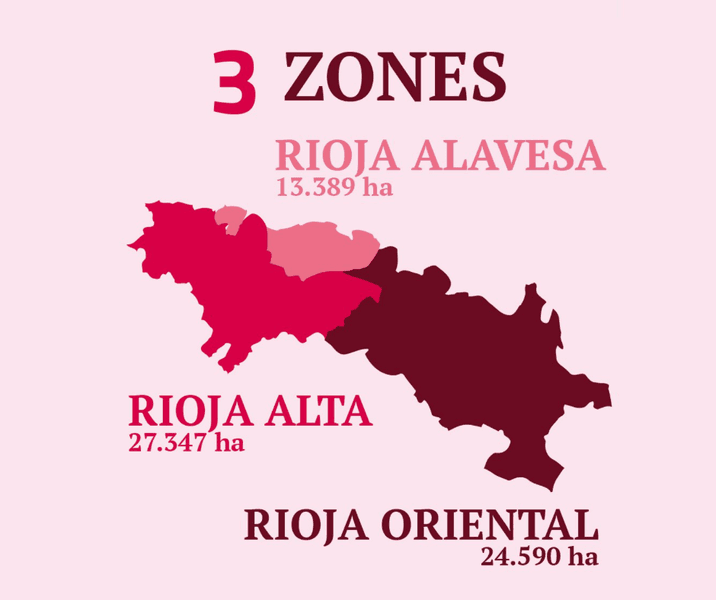When we think of Spanish wines, Rioja is usually the first region that comes to mind. That could be because, in 2018, Rioja accounted for 47.3% of Spanish wine sold in the UK by value. It’s a popular choice! While the region is mainly known for the Tempranillo grape, there are actually 9 other key different varieties to explore if you want to give your palate a new, exciting experience. Here we take a look at the Rioja wine region, its grapes and what you should be looking for when buying a bottle.
Rioja: one region, three zones
Rioja runs over a 75 mile stretch of land to the North of Spain, in Basque country, a few hundred miles from the border with France. Rioja is made up of 3 different regions:
- Rioja Alta lies to the West, mainly on high ground, and produces lighter wines.
- Rioja Alavesa lies to the East. The warmer and dryer weather generally produces darker wines with a rich quality.
- Rioja Baja lies to the warmer South and delivers much thicker bodied wines, including the Garnacha.
 Source: uk.riojawine
Source: uk.riojawine
Crianza, Reserva... Rioja's aging classification
Wine production in Rioja is carefully regulated and there are specific guidelines for the different styles, mostly depending on the time they are aged:
- Joven: These are younger wines which don’t have oak ageing.
- Crianza: The wine needs to be in the oak barrel at least for a year and then left in the bottle for another year.
- Reserva: These have a year in the barrel and two years in the bottle.
- Gran Reserva: These spend two years in the barrel and three in the bottle.
Ten key indigenous grape varieties
Rioja is home to 10 key different indigenous grape varieties including Viura, Malvasia, Garnacha Blanca, Tempranillo, Garnacha, and Mazuelo. 87.6% of red wines from the region are made with using the Tempranillo grape and 70.4% of white wines are made from Viura. While the local industry depends primarily on red wine, things are beginning to change in the region with white and rosado wine gaining more visibility in recent years. Since 2007, wine makers have also been allowed to use small quantities international grape varieties in their wine blends. Let’s take a closer look at three grape varieties in the region:
Tempranillo
A light and fruity wine, this is by far the most popular grape in the Rioja. The older vintages can taste more full-bodied. Most Tempranillo wines are great for pairing with meaty or spicy dishes, particularly lamb. This is a great bottle to pull out at the barbecue too as it goes particularly well with grilled meats. For that matter, Tempranillo is the perfect accompaniment for that family Sunday roast as it pairs perfectly with beef and lamb. It also works with vegan or vegetarian dishes that have a kick to them like chilli as well as cheesy dishes such as lasagne.
Garnacha
Slightly more full-bodied than the Tempranillo, Garnacha is similar to the Shiraz grape and a good choice for any family meal. While it’s less widely grown in the region, Garnacha is great with roasts, especially lighter meats such as pork and chicken. It works especially well when paired with game like pheasant or pigeon. It pairs also with vegan options that have certain umami with ingredients such as mushrooms, nut butter and coconut oils.
Viura
This white wine grape is often used in blending but is popular on its own as well. It’s a wine that is acidic, crisp but fruity on the palate and works well with fairly light dishes such as shellfish and fish in general. It also pairs with food that uses cheese so is a good accompaniment to pasta and even pizza. For vegan options, it’s a fairly good all-rounder that should go well with any meal as long as it’s not too spicy. While many of the bottles of Rioja wine you find nowadays are from the Tempranillo grape, there are plenty of different varieties to choose from. If you are looking for a great wine that delivers the good, the Rioja region certainly has much to offer. It pays to take a much closer look. Explore our Rioja wines at Winebuyers.com


:fill(white):fill_transparent()/sylius_prod/blog/direct-from-vineyard-menu.png)
:fill(white):fill_transparent()/_static/mega-menu/spirits-direct-from.png)
:fill(white):fill_transparent()/_static/mega-menu/offers-best-wine-and-spirits-deals.png)
:fill_transparent()/sylius_prod/blog/rioja-wine-min-1.png)
No comments
Leave a comment